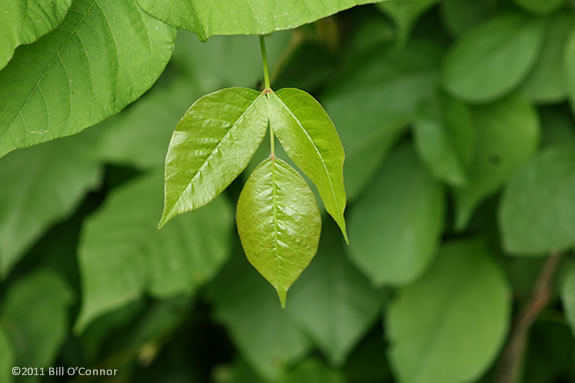
Anybody who has ever had a case of poison ivy will tell you that they wish they could go back in time and avoid ever having contact with the plant - and that's precisely the best way to deal with it. If you and your children can identify the plant and avoid coming into contact with the oily residue on its leaves, everyone is bound to have much more fun this summer!
There's an old saying that goes, "Leaves of Three, Let It Be" that refers to the three pointed leaves you'll find at the end of every poison ivy branch node. The leaves are shiny and green in the early Summer, that can turn slightly reddish as the season progresses into the Fall. By Fall, mature poison ivy will be producing berries and have very shiny leaves. As Autumn progresses, the leaves will turn yellow before they drop, but they still have the same glossy look.
The shine on the leaves is actually an oil called urushiol produced by the plant, which is also the irritant that causes poison ivy's rash. This oil is released when the leaves or other parts of the plant are burned, damaged or bruised. There are varying degrees of allergic reactions to poison ivy ranging from complete immunity to mild irritation to life threatening reactions. Most adults exposed to 50 micrograms (equal to a grain of salt) of urishiol will develop a rash, commonly referred to as a contact dermatitis.
The rash affects people differently, but it can spread quickly and in some cases cause debilitating misery. The rash is red and itchy accompanied with bumps and blisters that can grow rather large and fill with fluid. There are over-the-counter topical medications may relieve symptoms for most people, but immediate medical attention may be required for severe reactions, especially for people who have inhaled the smoke of burning plants because the oil could coats the throat, bronchi and lungs.
Make a PI Kit
If you come into contact with Poison Ivy, you want to remove the poison ivy oil residue ASAP. If you have the things you need on hand or in the car, you'll be saving yourself and your kids a lot of problems. So make sure you have a PI Kit handy containing:
- A bottle of rubbing alcohol
- Alcohol wipes
- Poison Ivy Soap - there are many brands
- Use Dish Detergent as a substitute - it's designed to remove oil and grease.
- A fingernail brush
- Bottled Water
Symptoms of poison ivy
- Red rash within a few days of contact
- Possible bumps, patches, streaking, or weeping blisters (blister fluids are not contagious)
- Swelling
- Itching
Prevention
- Develop the ability to identify poison ivy and stay away from it!
- Wear long sleeves an pants where poison ivy is ubiquitous.
- Barrier skin creams, such as a lotion containing bentoquatum, may offer some protection before contact.
- Don't burn poison ivy.
- Wash pets that come into contact with poison ivy frequently.
- Carry Alcohol wipes with you when in the woods or at the beach
- using alcohol wipes to remove oil residue left behind by brushing against a plant can save you a lot of hassle.
First Aid
- If you come into contact with poison ivy your primary goal should be to get the oily residue off of your skin.
- Try to wash yourself immediately with soap and water or rinse your skin with rubbing alcohol.
- Keep rinsing frequently to make sure that residual oils are completely removed from your skin.
- Minimize touching other people or parts of your body until you have completely washed.
- Kids that have come into contact with poison ivy and then touch their genitals while going to the bathroom can cause themselves serious medical problems!
- Wash or throw away all clothes and other objects that come into contact with poison ivy.
- Oily residue from poison ivy can remain active on a surface for up to 5 years!
- If you're at the beach, get in the water and stay in until your fingers 'prune', this is a sign that all residues are gone from your skin and your body is giving up it's own oils from within the skin.
- Make sure to scrub your finger nails with a stiff brush and plenty of soap and water, or soak them in rubbing alcohol
- Blisters
- If blistering occurs, they will fill with fluid and burst or be scratched open.
- Blister fluids are not contagious
- Treat the itching
- Calamine lotions and cortisone creams will reduce itching and blistering.
- Follow the directions on any creams and lotions. Do not apply creams to broken skin, such as open blisters.
- Oatmeal baths may relieve itching.
- Swimming in salt water will help relieve itching and dry out the rash.
- Antihistamine: Because the rash is caused by an allergic reaction, an antihistamine like Benadryl (diphenhydramine) can help with itching and other symptoms and reduce your body's reaction.
- Always follow directions on the package.
- If you are uncertain about taking medication or giving it to your child, call your doctor first, to determine the appropriate dosage!
- In severe cases or if the rash is on the face or genitals, seek professional medical attention as soon as possible.





















